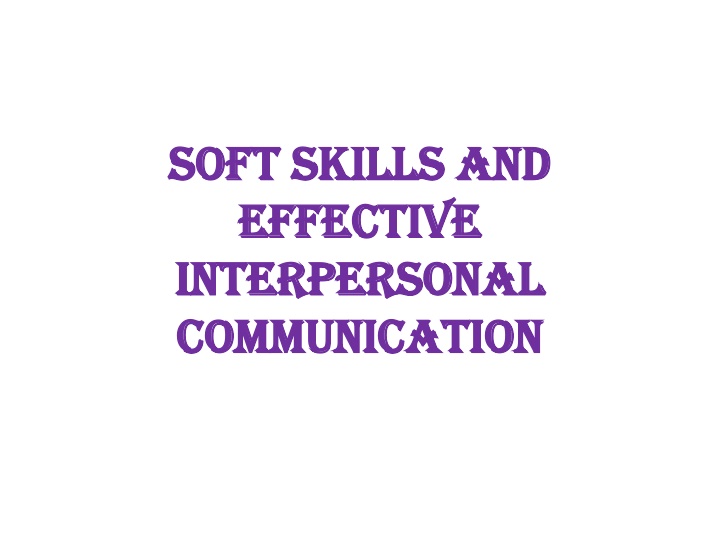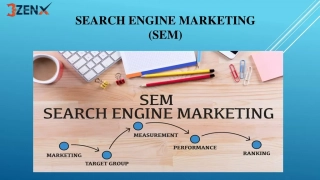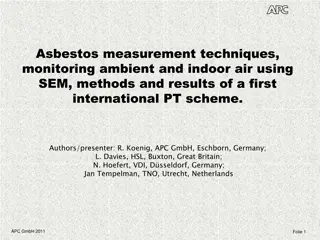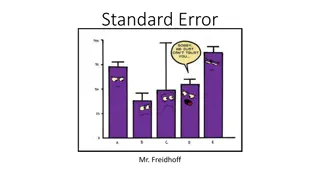
Effective Interpersonal Communication and Soft Skills Guide
Enhance your communication skills with this comprehensive guide on soft skills, effective listening, steps for effective communication, methods of communication, public speaking, presentation skills, and overcoming barriers to effective communication.
Download Presentation

Please find below an Image/Link to download the presentation.
The content on the website is provided AS IS for your information and personal use only. It may not be sold, licensed, or shared on other websites without obtaining consent from the author. If you encounter any issues during the download, it is possible that the publisher has removed the file from their server.
You are allowed to download the files provided on this website for personal or commercial use, subject to the condition that they are used lawfully. All files are the property of their respective owners.
The content on the website is provided AS IS for your information and personal use only. It may not be sold, licensed, or shared on other websites without obtaining consent from the author.
E N D
Presentation Transcript
Soft skills and Soft skills and effective effective interpersonal interpersonal communication communication
Effective Listening A dynamic process. It means attentiveness and interest perceptible in the posture as well as expressions. Active process. Physical and psychological efforts.
Features of good and effective listener Attentive Does not assume Listen for feelings and facts Concentrate on the other speakers kindly and generously Opportunizes
Steps for effective listening Intend to listen Be patient Maintain eye contact Identify emotions Acknowledge the speaker Show interest What s missing
Methods of communication Verbal A. Oral B. Written Non verbal A. Kinesics (Body language) B. Oculesics (Eye contact) C. Haptics (Touch) D. Proxemics (Space) E. Chronemics (Time) F. Paralinguistics (Volume speed, pitch, pauses)
Public speaking It is a process of speaking to a group of people in a structured , deliberate manner intended to inform, influence or entertain the listeners. Five basic elements are: Clear message Preparation Keep the sentence crisp and short Be eloquent Attitude should be neutral and relaxed
Barriers to effective communication Physical Language Cultural Psychological
Barriers to effective communication Physical Environmental Subjective strain Media ignorance Noise Time Distance Faulty instruments
Barriers to effective communication Language Lack of knowledge Accent and pronunciation Voice control Improper tone Jargon Ambiguity Use of vocabulary Communication overload and underload Roundabout Verbiage
Barriers to effective communication Cultural Inability to note and read the symbols Tendency to attach to the symbol meanings Punctuality Styles of greetings Relationships
Importance of body language Confident body language improves job opportunities. Non verbal gestures help us to understand feelings in a better way. Prevent misunderstandings. Convince others to accept what we have to say. Improves our successful interactions with everyone
Importance of body language Confident body language improves job opportunities. Non verbal gestures help us to understand feelings in a better way. Prevent misunderstandings. Convince others to accept what we have to say. Improves our successful interactions with everyone
Channels of communication Formal Vertical = Upward Downward Horizontal Diagonal Informal - Grapevine
Applications, SOP and Resume Formal Applications Purpose Key elements Types Format of application Statement of Purpose Format Resume Types Format
Elements Purpose Planning Participation Informality Leadership Essentials Be natural Language skills Be assertive Be patient Be polite
Purpose of interview Preparations to be made by the interviewer Preparations to be made by the interviewee
Elements of presentation Establish a purpose of your presentations Build an audience profile Establish the key message of your presentation Develop and structure the content of your presentation Controlling the environment
Leadership skills and Team building Characteristic of effective leadership Vision Disciplined Daring Passionate Charismatic Persistent Resourceful Communication Relationship- building Persuasion Visioning Leaders are people who have followers.
Characteristic of effective leadership Risk taking Value in others Teamwork Coaching and development Decision making Planning
Styles of leadership Autocratic Bureaucratic Democratic Laissez faire Servant People oriented Neurocratic/ Task oriented Transactional Transformational
Team Building A team is a group of people working towards a common goal. Stages in team building Forming Storming Norming Performing Adjourning or Mourning
Essentials of effective team building Good team leader Understanding and Collaboration Building trust Active participation Effective Communication Managing Conflict


















